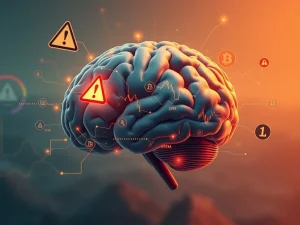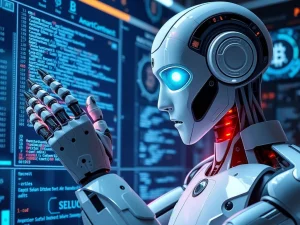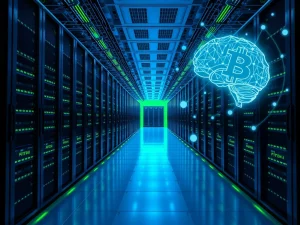Decentralized AI: How Blockchain AI Crucially Threatens True Innovation

The convergence of artificial intelligence and Web3 technologies holds immense promise. Many anticipate a future where AI systems are more transparent, secure, and user-controlled. However, a critical issue has emerged within this burgeoning sector. The very integration of blockchain technology, often seen as foundational for Web3, sometimes hinders genuine decentralized AI progress. This article explores how a blockchain-first approach can inadvertently stifle innovation, particularly in projects seeking vital crypto funding.
The Web3 AI Conundrum: A Misguided Path?
The Web3 AI space faces a significant challenge. A common misconception equates “decentralized AI” solely with “blockchain AI.” This equivalence is not accurate. Furthermore, it actively impedes genuine progress. Excellent decentralized AI projects often reshape themselves to fit blockchain frameworks. They do this not because it offers technical advantages. Instead, it becomes the only way to access Web3 funding, expertise, and community resources. This blockchain-first mindset limits the potential of decentralized AI. In fact, it actively works against it, essentially cannibalizing its true form.
Distinguishing Web3 from Blockchain AI
Understanding the core principles of Web3 is essential. Web3 ideals originate from the cypherpunk movement. These principles include trustlessness, permissionlessness, censorship resistance, and user ownership. The industry has frequently overlooked a crucial distinction. Web3 philosophy differs significantly from blockchain technology itself. For example, BitTorrent embodies Web3 principles. Tor is also a Web3 technology. IPFS provides another clear example of Web3. Now, as Web3 AI gains significant hype, many find blockchains are often poorly suited for its specific needs.
Consider the typical patterns within Web3 AI development. Brilliant teams build distributed learning networks. They create peer-to-peer (P2P) AI marketplaces. They also develop distributed training systems. Yet, they awkwardly explain the necessity of a token. They also detail how their on-chain settlement operates. This indicates a forced integration. As a counterexample, examine federated learning. Multiple nodes collaborate to train a shared AI model in this system. They simultaneously keep their raw data private. This represents a prime example of decentralized AI. Importantly, no tokens are required for its operation.
Incentives Driving Blockchain Integration and Crypto Funding
Blockchain technology certainly offers specific benefits. On-chain settlement can simplify payments between AI agents. Cryptographic proofs can improve reputation systems. Tokens can also align incentives in collaborative training. However, these are specialized tools. They are not universal solutions for every problem. For many decentralized AI challenges, blockchain overhead simply adds latency, complexity, and cost. Therefore, projects must evaluate its necessity carefully.
Why do projects frequently adopt these blockchain-centric decisions? The answer lies in the evolution of the Web3 ecosystem. Projects without blockchain integration often receive no recognition as “Web3.” Consequently, they cannot access vital Web3 funding pipelines. They also miss out on expert networks and community resources. Venture funds with a “Web3” mandate have built investment criteria around blockchain integration. Similarly, Web3 AI communities often deem non-blockchain projects out of scope. These powerful incentives drive teams to adopt blockchain. They do so not for product-specific reasons. Instead, they seek ecosystem access. This means architectural decisions stem from fundraising requirements. They do not come from optimal user outcomes. Playing this game is understandable. However, it means many opportunities for genuine and profitable applications of decentralized AI are being overlooked.
Unlocking True AI Innovation: Differentiating Key Concepts
The industry must acknowledge that three distinct concepts have been artificially bundled together. Recognizing these differences is crucial for fostering true AI innovation:
- Decentralized AI: This category includes distributed computing, federated learning, P2P networks, and edge computing. None of these inherently require blockchain infrastructure. They focus on distributing control and data.
- Crypto-integrated AI: This involves token incentives, cryptographic proofs, and digital asset management. It includes legitimate use cases that can be implemented using blockchains.
- Web3 AI: This represents user ownership, permissionless innovation, and community governance. These goals can be achieved through multiple technological approaches, not just blockchain.
These concepts can work together seamlessly. However, they do not always need to be combined. A federated learning network, for instance, can use cryptographic privacy guarantees. It does not need to touch a blockchain. A distributed AI marketplace can implement reputation-based validation. It does not require smart contracts. Incentive systems can operate through consensus mechanisms. These mechanisms do not always demand the overhead of an entire blockchain infrastructure. Therefore, flexibility in approach is vital.
Embracing Technological Pluralism for Decentralized AI
True innovation in decentralized AI demands technological pluralism. Blockchain should be considered a tool within a larger toolkit. It should not be a mandatory requirement. The most successful projects in the coming decade will choose the right architecture. They will select solutions tailored to their specific challenges. They will not conform to current ecosystem expectations. Web3 funding and community support must evolve. They need to embrace non-blockchain decentralization. Venture funds can achieve substantial returns on decentralized projects. These projects can align with Web3 ideals, even if their funding model is not token-based.
Communities should celebrate permissionless innovation. This applies regardless of its technical substrate. Numerous decentralized AI ecosystems exist beyond the crypto sphere. Some are nonprofit, while others are for-profit. Prime Intellect, for example, has trained large language models at scale. It has also preserved decentralization in its operations. The Massachusetts Institute of Technology’s NANDA project is building a decentralized internet of agents. LAION actively democratizes AI research. These systems achieve genuine decentralization. However, they do not carry a blockchain badge. Consequently, much of the Web3 community overlooks them. This oversight represents a missed opportunity for broader collaboration and learning.
Pathways to Genuine Decentralization and Future AI Innovation
Even within the more traditional Web3 AI space, positive signals are emerging. Some projects use blockchains only when it genuinely makes sense. Numerai, for instance, utilizes the chain to manage stakes for models. These models are developed by its community. It rewards the best-performing ones effectively. Torus Network transparently distributes token rewards. It gives them to agents contributing most to its long-term growth. It also captures network value within its token. Render Network’s token-based payment system means anyone, anywhere, can provide compute power. They contribute to its render farm seamlessly. These applications are already operational and demonstrate thoughtful blockchain integration.
The current blockchain-first approach is constraining innovation. This is happening precisely when it is needed most. As AI systems become more powerful, they also become more centralized. This trend creates a desperate need for decentralized alternatives. However, these alternatives will not flourish if the ecosystem continues forcing every solution through the blockchain bottleneck. Projects that shed this inefficient mindset today will dominate the ecosystem tomorrow. This represents a pivotal moment for the sector.
The Future of Decentralized AI
Web3 AI faces a critical choice. It can continue cannibalizing decentralized AI with rigid blockchain requirements. Alternatively, it can liberate it to achieve its full potential. The underlying technology is ready for this evolution. The crucial question remains: Is the ecosystem prepared to adapt? Furthermore, who will be able to capitalize on this significant change? The future of truly decentralized, open, and user-owned AI depends on this shift in perspective. It requires embracing a broader vision beyond just blockchain integration.









